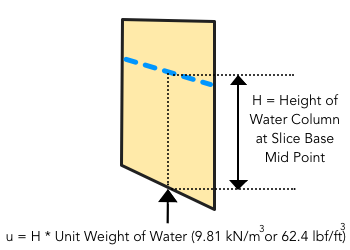3.4 Pore Pressure Conditions
- MacSlope allows pore pressure conditions to be assigned for each material in the drawing, through the use of a pore pressure coefficient, ru or B-bar, or with a piezometric surface.
- Pore pressure conditions can be assigned to a material using the Material Editor Tool
 .
.
Piezometric Surfaces
- MacSlope calculates the pore pressure at the base of a slice from a piezometric surface as follows:

Working with Piezometric Surfaces
- Click Define Piezometric Surface
 in the tool palette, or select Define Piezometric Surface from the Analysis Menu.
in the tool palette, or select Define Piezometric Surface from the Analysis Menu.
- The Piezometric Surface Pane is displayed to the right of the drawing. It contains a list of all the points that make up the lines for the piezometric surfaces in the drawing geometry.
- The Current Piezometric Surface is indicated
 in the table. Click the desired surface row in the table to change the current surface.
in the table. Click the desired surface row in the table to change the current surface.
- Click the Add Surface button to add a new piezometric surface to the drawing.
- Click the Remove Surface button to remove the current piezometric surface from the drawing. All lines belonging to that surface are removed.
- Click the Edit Points
 button to edit point locations, similar to when using the Line tool.
button to edit point locations, similar to when using the Line tool.
- Click and move your cursor inside the drawing bounds to create lines for the Current Piezometric Surface.
- A piezometric surface identifier number is drawn above each line to indicate which piezometric surface it is a part of.
- A piezometric surface can not contain piezometric lines with multiple piezometric elevations for the same distance coordinate.
- An unlimited number of piezometric surfaces may be drawn in one drawing geometry for use with different materials. Once drawn, the piezometric surface is available to be assigned from the material editor tool.
Import Point Geometry
- Click the Import Geometry button in the specified surface pane to import specified surface geometry from a .csv file, or from the clipboard (ie. copy and paste).
- The .csv file containing the point geometry must contain only 2 columns - distance and elevation. When the points are imported, a new specified surface is created from points in the order they are provided.
- When importing from the clipboard, copy 2 columns of distance-elevation coordinates from a typical spreadsheet application. A new specified surface is created between points in the order they are provided.
ru Coefficients
- Pore pressure may be specified through the use of an ru coefficient, defined as:

B-bar Coefficients
- Pore pressure may be specified through the use of a B-bar coefficient, defined as:

- If the Loads B-bar Materials field is enabled for a material in the material editor tool, that material will contribute towards the pore pressure acting at a slice base where that material is encountered above the slice base, with Δσ1 equal to the vertical pressure exerted by the total unit weight from that material.
Combining piezometric surfaces and pore pressure coefficients
- It is possible to combine the use of piezometric surfaces and pore pressure coefficients in MacSlope.
- Pore pressures generated at the slice base by piezometric surfaces and pore pressure coefficients are added to each other.
- Caution is advised as assigning pore pressure conditions by multiple methods for the same material can be confusing. Plots of the base pore pressure and base pore force with distance over the slip surface can be made with the Inspector Tool
 to ensure the pore pressure conditions are as expected.
to ensure the pore pressure conditions are as expected.
 .
.
 in the tool palette, or select Define Piezometric Surface from the Analysis Menu.
in the tool palette, or select Define Piezometric Surface from the Analysis Menu. in the table. Click the desired surface row in the table to change the current surface.
in the table. Click the desired surface row in the table to change the current surface. button to edit point locations, similar to when using the Line tool.
button to edit point locations, similar to when using the Line tool.

 to ensure the pore pressure conditions are as expected.
to ensure the pore pressure conditions are as expected.